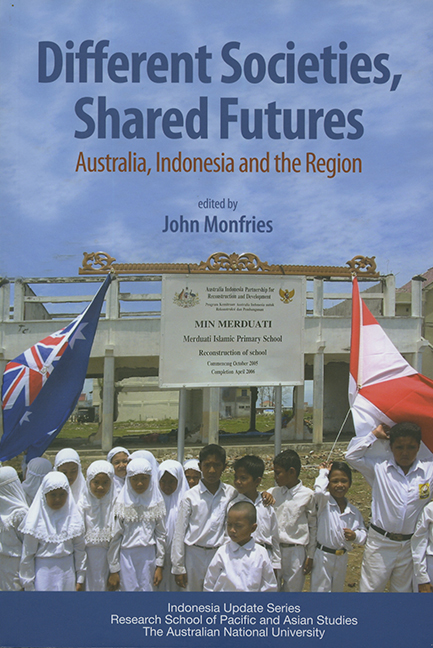Book contents
- Frontmatter
- Dedication
- Contents
- Tables
- Figures
- Contributors
- Acknowledgments
- Opening Address by Richard Woolcott AC
- 1 Introduction
- PART I Regional Viewpoints
- 2 An Indonesian View: Indonesia, Australia and the Region
- 3 A Regional View: The Garuda and the Kangaroo
- 4 An Australian View: The Outlook for the Relationship
- PART II Security Aspects
- PART III Mutual Perceptions and Irritations
- PART IV The Economic Partnership: Aid, Economics and Business
- PART V Conclusion
- Glossary
- References
- Index
4 - An Australian View: The Outlook for the Relationship
from PART I - Regional Viewpoints
Published online by Cambridge University Press: 21 October 2015
- Frontmatter
- Dedication
- Contents
- Tables
- Figures
- Contributors
- Acknowledgments
- Opening Address by Richard Woolcott AC
- 1 Introduction
- PART I Regional Viewpoints
- 2 An Indonesian View: Indonesia, Australia and the Region
- 3 A Regional View: The Garuda and the Kangaroo
- 4 An Australian View: The Outlook for the Relationship
- PART II Security Aspects
- PART III Mutual Perceptions and Irritations
- PART IV The Economic Partnership: Aid, Economics and Business
- PART V Conclusion
- Glossary
- References
- Index
Summary
History suggests that this may be a dangerous time in Australia–Indonesia relations. We have now reached another high tide in government-to-government relations. I remember the two previous such occasions – in the early 1970s under Prime Minister Gough Whitlam and President Soeharto, and in the 1990s under Prime Minister Paul Keating and President Soeharto. Both these high tides ended in tears and recriminations because the relationship lacked a sufficiently firm foundation or, to use former Foreign Minister Gareth Evans’ word, ‘ballast’. On both occasions East Timor was the trigger for significant setbacks.
It is a reminder that bilateral relations are hostage to the latest chapter in this complex story of Indonesian nationhood and the response of Australian public opinion to the Indonesian project. I am not predicting that the current high tide will end in tears and recriminations. However, I expect relations will oscillate between their good and bad phases and that Australia–Indonesia ties will be subject to more volatility and unpredictability than any of Australia's other main relationships.
In these remarks I have six potentially contradictory points to make. First, government-to-government relations in 2005 revealed, again, the crucial role of a personal relationship between the heads of government. John Howard and Susilo Bambang Yudhoyono (SBY) have such a personal relationship and mutual trust. This rapport is important in helping to set the tone for their respective governments. While the significance of such heads-of-government ties can be exaggerated, history suggests they are pivotal.
When President Yudhoyono visited Australia in April 2005, he said relations were getting ‘stronger, closer, better’. In a sophisticated speech he conceptualised relations the way Australia likes to see them. He acknowledged the need for better people-to-people links – a critical defect in the relationship. Yudhoyono was, however, very ambitious for the relationship, far more ambitious than any previous Indonesian president. This is a very encouraging sign. Without doubt, he is the best Indonesian president for Australia. But this is also a trap, since there is no guarantee that his successor will be as enthusiastic or ambitious about ties with Australia.
- Type
- Chapter
- Information
- Different Societies, Shared FuturesAustralia, Indonesia and the Region, pp. 34 - 38Publisher: ISEAS–Yusof Ishak InstitutePrint publication year: 2006

